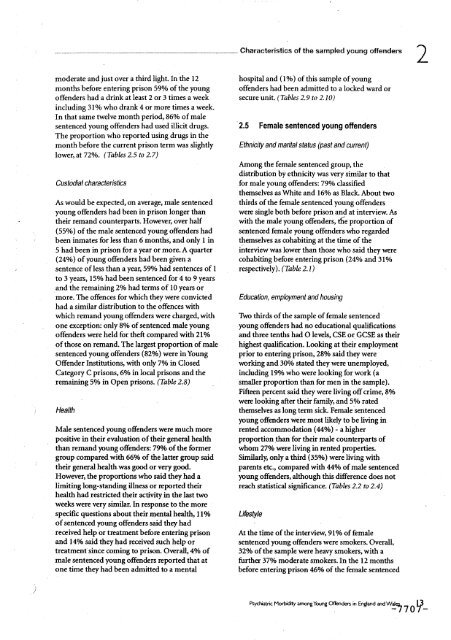Neurotic disorders
Neurotic disorders
Neurotic disorders
Create successful ePaper yourself
Turn your PDF publications into a flip-book with our unique Google optimized e-Paper software.
Characteristics of the sampled young offenders j)<br />
moderate and just over a third light. In the 12 hospital and (1%) of this sample of young<br />
months before entering prison 59% of the young offenders had been admitted to a locked ward or<br />
offenders had a drink at least 2 or 3 times a week secure unit. (Tables 2.9 to 2.10)<br />
including 31% who drank 4 or more times a week.<br />
In that same twelve month period, 86% of male<br />
sentenced young offenders had used illicit drugs. 2.5 Femalesentenced youngoffenders<br />
The proportion who reported using drugs in the<br />
month before the current prison term was slightly Ethnicityandmantelstatus(pastandcurrent)<br />
lower, at 72%. (Tables Z5 to 2.7)<br />
Custodialcharacteristics<br />
Among the female sentenced group, the<br />
distribution by ethnicity was very similar to that<br />
for male young offenders: 79% classified<br />
themselves as White and 16% as Black. About two<br />
As would be expected, on average, male sentenced thirds of the female sentenced young offenders<br />
young offenders had been in prison longer than were single both before prison and at interview. As<br />
their remand counterparts. However, over half with the male young offenders, t/_e proportion of<br />
(55%) of the male sentenced young offenders had sentenced female young offenders who regarded<br />
been inmates for less than 6 months, and only 1 in themselves as cohabiting at the time of the<br />
5 had been in prison for a year or more. A quarter interview was lower than those who said they were<br />
(24%) of young offenders had been given a cohabiting before entering prison (24% and 31%<br />
sentence of less than a year, 59% h_id sentences of 1 respectively). (Table 2. I)<br />
to 3 years, 15% had been sentenced for 4 to 9 years<br />
and the remaining 2% had terms of 10 years or<br />
more. The offences for which they were convicted Education, employment and housing<br />
had a similar distribution to the offences with<br />
which remand young offenders were charged, with Two thirds of the sample of female sentenced<br />
one exception: only 8% of sentenced male young young offenders had no educational qualifications<br />
offenders were held for theft compared with 21% and three tenths had O levels, CSE or GCSE as their<br />
of those on remand. The largest proportion of male highest qualification. Looking at their employment<br />
sentenced young offenders (82%) were in Young prior to entering prison, 28% said the), were<br />
Offender Institutions, with only 7% in Closed working and 30% stated they were unemployed,<br />
Category C prisons, 6% in local prisons and the including 19% who were looking for work (a<br />
remaining 5% in Open prisons. (Table 2.8) smaller proportion than for men in the sample).<br />
Fifteen percent said they were living off crime, 8%<br />
were looking after their family, and 5% rated<br />
Health themselves as long term sick. Female sentenced<br />
young offenders were most likely to be living in<br />
Male sentenced young offenders were much more rented accommodation (44%) - a higher<br />
positive in their evaluation of their general health proportion than for their male counterparts of<br />
than remand young offenders: 79% of the former whom 27% were living in rented properties.<br />
group compared with 66% of the latter group said Similarly, only a third (35%) were living with<br />
their general health was good or very good. parents etc., compared with 44% of male sentenced<br />
However, the proportions who said they had a young offenders, although this difference does not<br />
limiting long-standing illness or reported their reach statistical significance. (Tables 2.2 to 2.4)<br />
health had restricted their activity in the last two<br />
weeks were very similar. In response to the more<br />
specific questions about their mental health, 11% Lifestyle<br />
of sentenced young offenders said they had<br />
received help or treatment before entering prison At the time of the interview, 91% of female<br />
and 14% said the)" had received such help or sentenced young offenders were smokers. Overall,<br />
treatmentsince coming to prison. Overall, 4% of 32% of the sample were heavy smokers, with a<br />
male sentenced young offenders reported that at further 37% moderate smokers. In the 12 months<br />
one time they had been admitted to a mental before entering prison 46% of the female sentenced

















